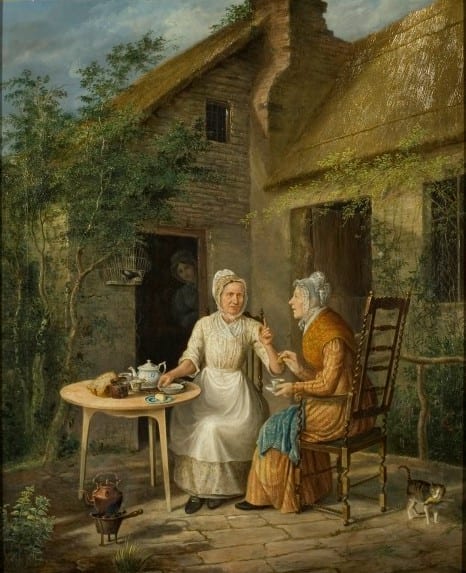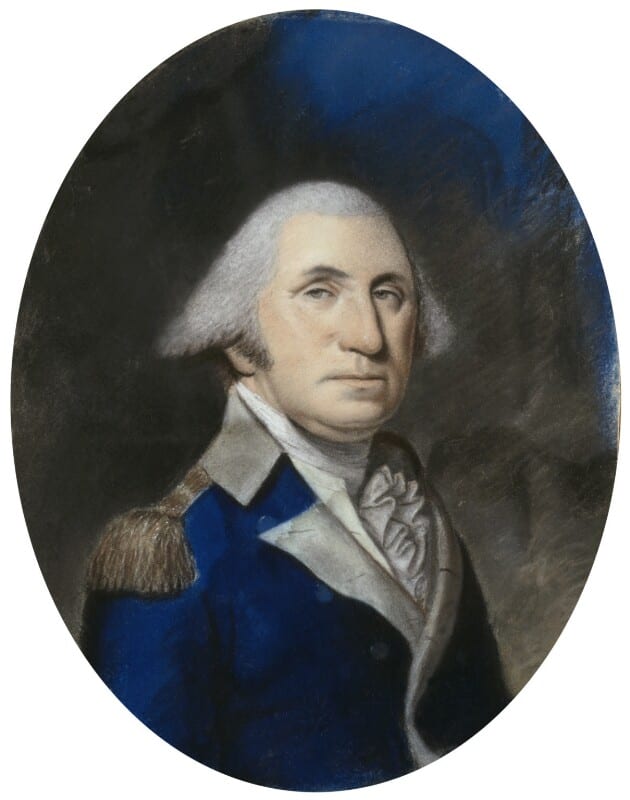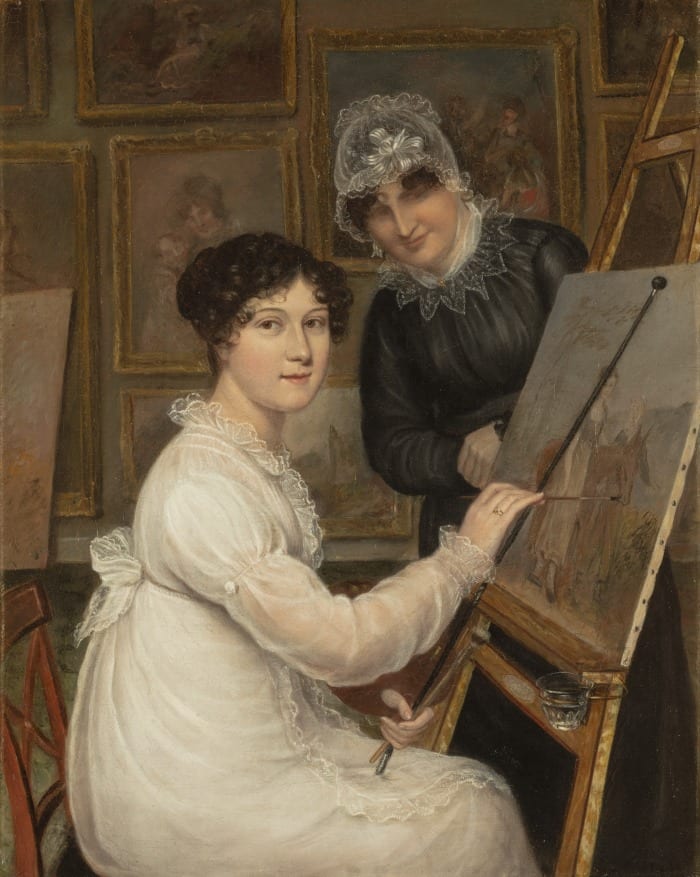Bristol’s Rolinda Sharples and her American Connections
By Michael Hartman
On a rather cold and blustery winter day in Bristol, students and professors on the 2019 British Design History Trip welcomed the respite offered by the city’s Museum and Art Gallery. The institution’s origins date to 1823, and it boasts collections spanning natural history, local and global archaeology, geology, and the arts. As the lone Art History Ph.D. student accompanying the Winterthur Fellows on their annual trip, I was delighted when I stumbled across a red room on one of the upper floors dedicated to the Bristol School of Artists where an 1828 painting entitled The Village Gossips immediately caught my eye.

Rolinda Sharples, The Artist and Her Mother, 1816, oil on canvas, City of Bristol Collection, purchased 1931.
Two women sipping tea seem rather engaged in an animated discussion that has drawn a third woman into the doorframe of the thatched roof cottage. Unnoticed by the pair, she leans forward, eavesdropping as the woman in white raises her finger to emphasize her point. The playful subject matter reflects a broader trend in nineteenth-century painting in Britain and the United States to embrace ‘everyday’ scenes in artistic practice. As I glanced at the museum’s label and read the artist’s name, Rolinda Sharples, I immediately recalled another artist with the same surname, James Sharples, who was active in the US in the 1790s and early 1800s. I wondered: could there be a relationship between them?
Like the history of art, the history of design incorporates the study of objects and people set in motion, locally or internationally, who influence the innovation, development, and production of material goods. As it turned out, Rolinda was James’s daughter born in 1794, the same year James and his wife, Ellen, moved the family to the United States. James and Ellen were accomplished pastellists and moved the family from town to town between 1794 and 1801 making portraits of George Washington, John Adams, and other statesmen.

Ellen Sharples, after James Sharples, George Washington, 1796-1797, pastel, National Portrait Gallery, London, given by T.H. Russell and Mrs. Alexander Scott, 1936.
They returned to Britain in 1801 before coming back to the United States a second time in 1809 where they remained until James’s death in 1811. Ellen Sharples then brought her family back to England where they settled in Bristol, and she took over Rolinda’s education. This training is reflected in Rolinda Sharples’1816 painting of The Artist and Her Mother.

Rolinda Sharples, The Artist and Her Mother, 1816, oil on canvas, City of Bristol Collection, purchased 1931.
Sharples sits at her easel with a maulstick and palette in one hand and raises her brush in the other, painting an outdoor scene of a young woman standing in front of a horse with a boy in the background. The artist’s mother, Ellen, peeks her head around to check her daughter’s progress. Ellen Sharples’ husband trained her in pastel, and their works are often indistinguishable from one another. She in turn trained Rolinda in pastels; the almost powdery nature of her mother’s face, while rendered in oil, recalls the pastel tradition mastered by her mother and father.
This young artist, raised in America but active in Britain, developed a style that would have appealed to Americans and Britons alike in both her portraits and her scenes of everyday life. Her works garnered high praise, and Rolinda Sharples exhibited at the Royal Academy in 1820, 1822, and 1824. She established her artistic career in England, but her childhood in the United States perhaps influenced her artistic development. We might even wonder: did a young Rolinda watch her father draw this “Unknown Man” now in the Winterthur collection?

James Sharples, Portrait of an Unknown Man (formerly Mr. Jarrett), 1795-1801, pastel on paper, Winterthur Museum, bequest of Henry Francis du Pont.
While we will never know, the Bristol Museum and Art Gallery and Winterthur collections will forever be intertwined by the Sharples family of artists who travelled between Britain and the United States in the early-nineteenth century.

Leave a Reply